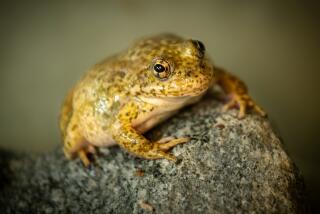Small Bird Singing Sweet Song of Success in Southland
People driving over the Santa Clara River bridge on the Ventura Freeway are unaware of it, but a remarkable survival story is unfolding just below in a thicket along the river.
A small songbird with an enchanting repertoire of melodies and legendary navigation skills is tending a clutch of hungry fledglings. This is one of about 80 pairs of least Bell’s vireos occupying a 40-mile stretch of the Santa Clara.
That may not sound like much, but it represents an extraordinary recovery for a creature that was pushed to the brink of extinction in the 1980s by human encroachment and a ruthless winged competitor. Across Southern California, from San Diego to San Bernardino, more than 2,000 pairs of vireos were counted last year, an eightfold increase over the low point in 1986.
“The birds are doing better and it’s great news,” said Jim Greaves, a Santa Barbara-based researcher who has charted the bird’s resurgence in Ventura County and elsewhere. “This is one of those success stories, but because it’s a small, little bird that you can’t see in zoos like an eagle or a hawk, people don’t really notice it. Yet the little things in nature are important.”
Although the species is a long way from being declared sound, its revival demonstrates that, as with the California condor and peregrine falcon, aggressive recovery efforts can pay off for even the most unfortunate fauna. That, experts say, offers hope that the vireo, one of 32 threatened birds in the state, can survive in an increasingly urban landscape.
Just as important, the bird’s comeback may prove that habitat along streams in Southern California is recovering from the effects of pollution caused by decades of urban development. That is a critical indicator of environmental health in a state that has lost 97% of its riparian woodlands, more than any other state.
“As the vireo goes, so go the wetlands,” said Loren Hays, a federal biologist.
Once common in California, least Bell’s vireos were noted by Gold Rush-era naturalists from the Mexican border nearly to Oregon, and from Monterey to Death Valley. They thrived in shady, wet woodlands, picking grasshoppers and caterpillars off bark and leaves.
The birds are easily identified by their distinct call, the first part of which sounds like cheedle-cheedle-chee, as if asking a question, and the second part, cheedle-cheedle-chew, as if answering.
As America rapidly developed after World War II, the vireos fell into serious trouble. Moist woodlands were cleared for crops. Dikes and dams prevented flood waters from replenishing riparian habitat. Livestock grazing damaged stream-side vegetation and brought with it a deadly avian enemy, the brown-headed cowbird, which ravaged vireos.
A nonnative species, cowbirds forage in livestock feedlots and prey on the nests of vireos and 129 other bird species. They either toss out vireo eggs or peck holes in them--a single female cowbird can displace 40 eggs in a season--and replace them with their own.
The vireos unwittingly incubate the larger cowbird eggs until they hatch. Any vireo chicks lucky enough to hatch too are quickly overwhelmed by the larger, more aggressive cowbird chicks, which better compete for food the parent vireo brings.
As a result of the twin threats of urbanization and cowbird predation, the vireo declined to 268 pairs in 1986, when it was declared endangered. “Every nest I saw had a cowbird egg in it,” Greaves recalled from surveys on the Santa Clara River in 1991.
More than any other strategy, cowbird removal has benefited the vireos, scientists say. To give vireos a fighting chance, scientists use nets and deploy closet-size traps, often containing another bird as bait, to nab cowbirds. In the last decade, thousands of cowbirds have been killed with birdshot, gas or a swift pinch to the thorax.
The results have been remarkable. For example, at the Camp Pendleton Marine Corps base, where nearly half the vireo nests were disrupted in the 1980s, just 1% were vandalized by cowbirds in 1990 and none have been harmed since then, Greaves said. Similar gains are reported along the Santa Ana, San Luis Rey, Sweetwater and San Diego rivers.
In northern San Diego County, the number of pairs has surged to about 1,100, five times more than in 1986. At Camp Pendleton, they are now a common upland bird.
And on the vast, wooded flood plain behind Prado Dam that straddles Riverside and San Bernardino counties, long a vireo stronghold, 200 pairs now reside where just 30 were found more than a decade ago, according to the U.S. Fish and Wildlife Service.
But the bird’s resurgence in Ventura County is particularly important to its future. Establishing a viable population on the Santa Clara River, the region’s largest unchanneled stream, running from Newhall to the Pacific Ocean, is essential if the birds are to recolonize historical ranges in the San Joaquin and Salinas valleys and beyond.
Besides the pair in the nest near the freeway, vireos have been found at farms, in an orange grove near Fillmore and on local military bases.
“We’re finding more of them every year. We’re getting more comfortable with the fact that we won’t lose them,” said Robert Mesta, an ornithologist for the Fish and Wildlife Service office in Ventura.
Habitat protection efforts have helped, too. The Santa Clara River Trustee Council, for example, is devising a conservation plan to spend $7.1 million, the amount Arco paid for spilling oil into the river from a ruptured pipeline during the 1994 Northridge earthquake, to improve conditions for vireos and other species.
Despite the gains, the bird is a long way from being out of the woods. Costs to save the species will probably run $8.4 million through 2003, but even that expenditure will not be enough to allow the bird to flourish across California the way it once did, experts say.
“We have no illusions about returning it to the majority of its historic range, but we want to get some populations reestablished in areas where there used to be core populations, like the Central Valley, Salinas Valley and Sacramento Valley,” federal biologist Hays said.
Scientists are also concerned that the birds do not appear to be dispersing rapidly from San Diego and Riverside counties. The urban belt of Los Angeles and Orange counties and the Inland Empire may pose a formidable barrier preventing vireos from reaching watersheds to the north in significant numbers, Greaves said.
Preliminary estimates this year show slightly fewer vireos than last year, too, though scientists are not sure why and they caution against placing too much emphasis on year-to-year fluctuations.
“We believe this is a short-term setback,” Hays said. “Overall, the news is good. We’re hoping that growth will continue next year, and the available evidence suggests that should be the case.”
More to Read
Sign up for Essential California
The most important California stories and recommendations in your inbox every morning.
You may occasionally receive promotional content from the Los Angeles Times.










